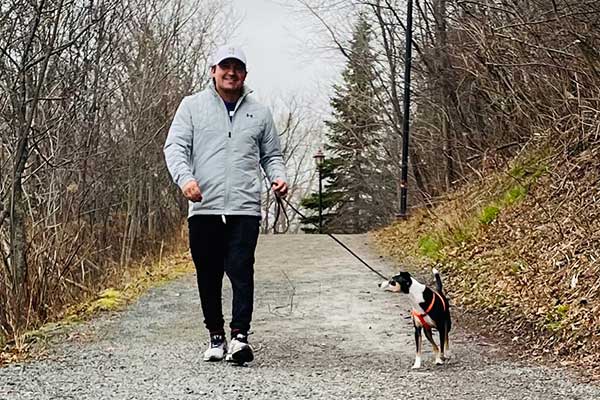
Aggression & Anxiety Increasing With Age
When Helper Dog Jacky was first adopted by Instinct Co-Founders Brian and Sarah at age 3, he came with some significant baggage. While he was smart, silly, and generally social, he also displayed significant fear-based behaviors in a variety of situations, from cowering and baring his teeth if someone reached too quickly to pet him, to freezing in place and urinating in response to simple obedience cues. He displayed conflict aggression related to certain high value resources, he struggled with impulsivity and separation anxiety, and he became easily overstimulated around fast movements and loud noises.
In the first 18-24 months of being adopted, Jacky made steady, positive strides; by age 5, his fear-based behaviors had decreased significantly as he learned to trust that he was safe and in control of most situations. He continued to struggle with impulsivity at times, but overall, had blossomed into a happy, confident little dog.
Then, starting around 7.5 years of age, Jacky’s old behaviors started to resurface, and some new ones emerged. He was quicker to become agitated and aggressive in response to normal everyday interactions. His responsiveness to cues decreased. His separation anxiety resurfaced. And he seemed generally less happy. The change in behaviors occurred following an extended vacation to visit family, then a painful bout of impacted anal glands.
To help Jacky regain his confidence and improve his ability to co-exist peacefully with his human and canine family members.
Jacky’s 8-week intervention plan included a heavy emphasis on assessing and supporting his overall behavioral health. Given his age and the relatively quick decline in his behavior, our initial steps included:
During the next 4-5 weeks, training & behavior modification exercises were minimal. We included some daily relaxation work, and reinstituted some basic “patient & polite” rules around food and doorways. We introduced daily flirt pole sessions as a way to satisfy Jacky’s terrier-ific genetic drives to chase, grab, and shake small furry things; and, we upped the number and types of long-lasting bones and chews available to him, to fulfill his desire to gnaw and lick.
Jacky began to show a notable decrease in his agitation level. He seemed happier and more waggy, and he started to solicit attention more frequently. His separation anxiety lingered, so medication levels were adjusted by Dr. Levine to provide further support him in that area.
Gradually, impulse control exercises were incorporated into Jacky’s daily flirt pole sessions; this served the dual purpose of helping to rebuild his self-control muscles and helping to re-establish his responsiveness to basic cues using a reinforcer we knew he absolutely LOVED.
Eight weeks out from his intervention kick-off, Jacky is a much happier boy. He continues to have less tolerance for being left alone than he did before, but he is coping better with a specific departure routine. We will continue to work on it, knowing that some level of decreased tolerance will likely occur as a natural part of him getting older. Otherwise Jacky is, very thankfully, back to is regular self! He is accepting of handling, more affectionate and snuggly and more responsive to our direction and guidance. He is also better able to recover and settle if he does get worked up.
“Jacky is a great example of the importance of adopting a “wide lens” view when designing behavior interventions for dogs with fear, anxiety, and aggression issues. Most often, it is necessary to think beyond specific training and behavior modification exercises, and design solutions that fully address our dogs’ current physical health, physiology, nutrition, and genetic needs.” -Brian (Jacky’s Human)
Help us learn more about your dog and your behavior goals, and we’ll help you implement a custom program that lets you and your dog live happier lives together, filled with fun, freedom and friendship.
You can also call your local Instinct location to speak to a trainer.